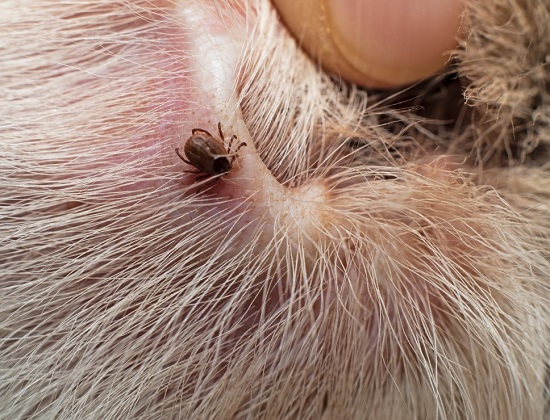Ticks are a part of life for dogs worldwide. But what can we do to save our furry friends from these vicious little creatures? That is exactly what we’re going to tell you, how to get rid of ticks on dogs. You will earn everything you want to know about keeping your dog safe from these annoying ticks.
What is a Tick and Its Life Cycle?
Ticks are insects that prey on the blood of dogs, cats, horses, and even people and carry a broad range of parasites they transmit when feeding on their victim’s blood. Dogs in rural areas or visit areas where animals like farm products or deer are found are most at risk.
More than 850 species of these tiny, parasitic arachnids are known. Ticks endure on the blood of host animals and are standard on animals with fur in which they can hide. There are two classifications of a tick: hard- and soft-bodied species.
Depending on their location, ticks may be carriers of diseases, generally Lyme Disease, that usually occur in wooded areas with large deer populations.
The tick life cycle is of four stages:
- Egg
- Larva
- Nymph
- Adult
Many species of ticks are more prevalent in the warmer months, as that is when numerous species hatch. Ticks can be found in most regions of the United States throughout the year.
How to Remove Ticks from Dogs
The tick removal procedure consists of 3 easy steps:
- You can use tweezers to get the head of the tick as close to the dog’s skin as possible.
- Pull with a steady, firm, upward motion.
- Use a disinfectant like rubbing alcohol or iodine to the injury to prevent infection.
It’s as simple as that. The key here is the detection and rapid eradication. So check your dog daily, and if you find ticks on your dog, make sure to remove them as soon as possible.
Tick Prevention for Dogs
Now that we know what ticks are and how to remove them let’s look into the best methods to control ticks.
Check Regularly
The first method to get rid of ticks on dogs is to check daily. Check your dog for ticks every day, and you’ll be capable of staying ahead of a tick issue. If ticks are breeding in your house, it’s best to catch them before and work toward maintaining a tick-free area for your dog.
Around the Yard/House
To keep your house free from ticks, there are several steps you can take.
Preventative steps are still the best long-term solution, and tick prevention starts with a dog’s environment. Ticks climb tall grasses and bushes to secure themselves to a passing host.
Avoid places in the height of tick season that pose a possible threat. If you have found ticks on your dog after visiting a specific area, do your best to avoid them and find another place to exercise your puppy.
Chemical sprays
Several chemical sprays can be applied to your yard. Exercise alert when using these sprays, mainly when using these chemicals in areas where your pet and children regularly visit. Some less powerful sprays can be bought in a pet store or online, but consult a vet or professional before applying these types of sprays.
The CCSPCA advises that area villagers use a professional pest control service. It ensures the safe handling of chemicals, a complete dousing of affected areas, and a more substantial chance of eradication.
Oral Medications
Oral medications are one of the most popular methods to get rid of ticks on dogs. There are many to choose from, typically lasting for about one month, so dosing doesn’t become a load. Moreover, a newer pet insecticide, Bravecto, can last up to 120 days, making it even easier on pet owners.
The medication stays in the dog’s bloodstream, quickly dispatches parasites, and prevents others from taking any long-term residency. These medications are generally very effective, but some have side effects for a few other breeds, so be sure to consult your vet before providing any medication to your dog.
Spot-on Treatments
Spot-on treatments are a very popular way to get rid of ticks on dogs. The treatment liquid or gel is generally applied between your dog’s shoulder blades, where they can’t reach it. The medication then enters the dog’s bloodstream, killing any ticks on the dog fast and similarly preventing future parasites to oral medications.
Be conscious of any skin reactions your dog may have, as some products can inflame or irritate the skin of specific animals. Also, keep your hands away from the application zone for the recommended period to avoid harmful contamination.
Tick Collars
Tick collars are an easy method to get rid of ticks on dogs. They are secured around the dog’s neck in the same manner as a traditional collar and use medicine to kill any ticks that come into contact with the area around the head and neck. The longevity of tick collars varies and can last up to 8 months, and it is the only one suggested by the CCSPCA.
Some medication also enters the dog’s bloodstream, making it less likely for other infestations. Make sure to keep away from touching the collar, and be sure to wash your hands if you do come into touch.
Tick Sprays
Tick sprays are the product you’ll find in many pet stores. Not only do they advise them for topical application on dogs, but many are also prepared to be spread within the house to help control other pests such as fleas.
Read the directions carefully before use. Make sure to use caution when using it and avoid contact with your skin if possible, as well as you or your dog breathing the spray. Also, consider whether or not this is the right product for you, specifically if you have small children.
Tick-borne Infections
As ticks represent a danger to your dog’s health through the infectious nature of their feeding habits, it’s only natural that we cover the symptoms of tick-borne infection.
Ticks are responsible for the transmission of many diseases, including:
- Lyme disease
- Anaplasmosis
- Ehrlichiosis
- Rocky Mountain Spotted Fever
Monitor your dog closely after being bitten by even a single tick, as that’s all it takes to infect them.
Signs
The symptoms of each of these diseases can be different, but pay attention for:
- General lameness
- Stiffness or Pain
- Inflammation and redness around the bite area
- Loss of appetite
- Reluctance to move, eat, etc.
- Vomiting
- Weakness
These are all symptoms of the various diseases listed above and should be treated as soon as possible.
What to Do
Ticks’ diseases can be severe and should be treated as early as possible. However, if your dog sounds any of the symptoms listed above, visit your vet instantly. Talk to them about the potential risk of infection and whether or not you’ve seen ticks on your dog.
Now that you know how to get rid of ticks on your dog, keep an eye out for symptoms. Monitor your dog if exposed to areas where ticks may be prevalent and check them daily.
 DogExpress
DogExpress




















 in Chandigarh, India.
in Chandigarh, India. 

